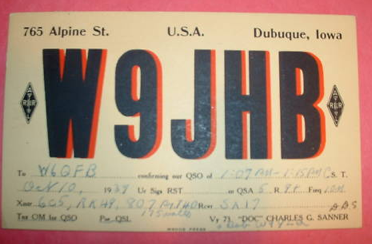Encyclopedia Dubuque
"Encyclopedia Dubuque is the online authority for all things Dubuque, written by the people who know the city best.”
Marshall Cohen—researcher and producer, CNN
Affiliated with the Local History Network of the State Historical Society of Iowa, and the Iowa Museum Association.
QSO: Difference between revisions
No edit summary |
No edit summary |
||
| Line 1: | Line 1: | ||
[[Image:QSO.png|left|thumb|250px|This QSO card from radio-W9JHB, Charles G. Sanner operating from Alpine Street, to radio W6QFB Kyhl Smeby transmitting from Los Angeles, California confirms their QSO on October 10, 1939. The reverse of the card was addressed, stamped, and postmarked on the same day.]] QSO. The Q code is a standardized collection of three-letter message encodings, all starting with the letter "Q." These were developed for commercial radiotelegraph communication and were later adopted by other radio services especially amateur radio. | [[Image:QSO.png|left|thumb|250px|This QSO card from radio-W9JHB, Charles G. Sanner operating from Alpine Street, to radio W6QFB Kyhl Smeby transmitting from Los Angeles, California confirms their QSO on October 10, 1939. The reverse of the card was addressed, stamped, and postmarked on the same day.]] QSO. The Q code is a standardized collection of three-letter message encodings, all starting with the letter "Q." These were developed for commercial radiotelegraph communication and were later adopted by other radio services especially amateur radio. | ||
Although Q codes were created when radio used Morse code exclusively, they continued to be used after the introduction of voice transmissions. To avoid confusion, transmitter call signs are restricted. While an embedded three-letter Q sequence may occur (for instance, VE3QRP is a radio amateur station dedicated to low-power operation), no country is ever issued an ITU prefix starting with "Q." The codes in the range QAA–QNZ are reserved for aeronautical use; QOA–QOZ for maritime use and QRA–QUZ for all services. | Although Q codes were created when radio used Morse code exclusively, they continued to be used after the introduction of voice transmissions. To avoid confusion, transmitter call signs are restricted. | ||
While an embedded three-letter Q sequence may occur (for instance, VE3QRP is a radio amateur station dedicated to low-power operation), no country is ever issued an ITU prefix starting with "Q." The codes in the range QAA–QNZ are reserved for aeronautical use; QOA–QOZ for maritime use and QRA–QUZ for all services. | |||
[[Image:kdthqso.png|left|thumb|250px|QSO card from KDTH]] | [[Image:kdthqso.png|left|thumb|250px|QSO card from KDTH]] | ||
[[Category: Broadcaster]] | [[Category: Broadcaster]] | ||
Latest revision as of 03:33, 17 June 2010
QSO. The Q code is a standardized collection of three-letter message encodings, all starting with the letter "Q." These were developed for commercial radiotelegraph communication and were later adopted by other radio services especially amateur radio.
Although Q codes were created when radio used Morse code exclusively, they continued to be used after the introduction of voice transmissions. To avoid confusion, transmitter call signs are restricted.
While an embedded three-letter Q sequence may occur (for instance, VE3QRP is a radio amateur station dedicated to low-power operation), no country is ever issued an ITU prefix starting with "Q." The codes in the range QAA–QNZ are reserved for aeronautical use; QOA–QOZ for maritime use and QRA–QUZ for all services.



